Norwegian Potato Lefse Recipe (With Video)
Ever since I was a little kid Norwegian lefse has been one of my favorite foods, especially when it’s filled with butter and sugar to make kling. And I’m certainly not alone in my love for lefse.
Lefse is a traditional soft Norwegian flatbread made with flour, butter, cream and sometimes potatoes. Potato lefse is not quite as common in Norway these days, but it is still very beloved in certain regions, with recipes passed down through generations. Potato lefse takes a bit more effort to make than the more popular wheat versions, but I think potato lefse is well worth the extra effort! I’ve also shared my semolina recipe from Telemark here.
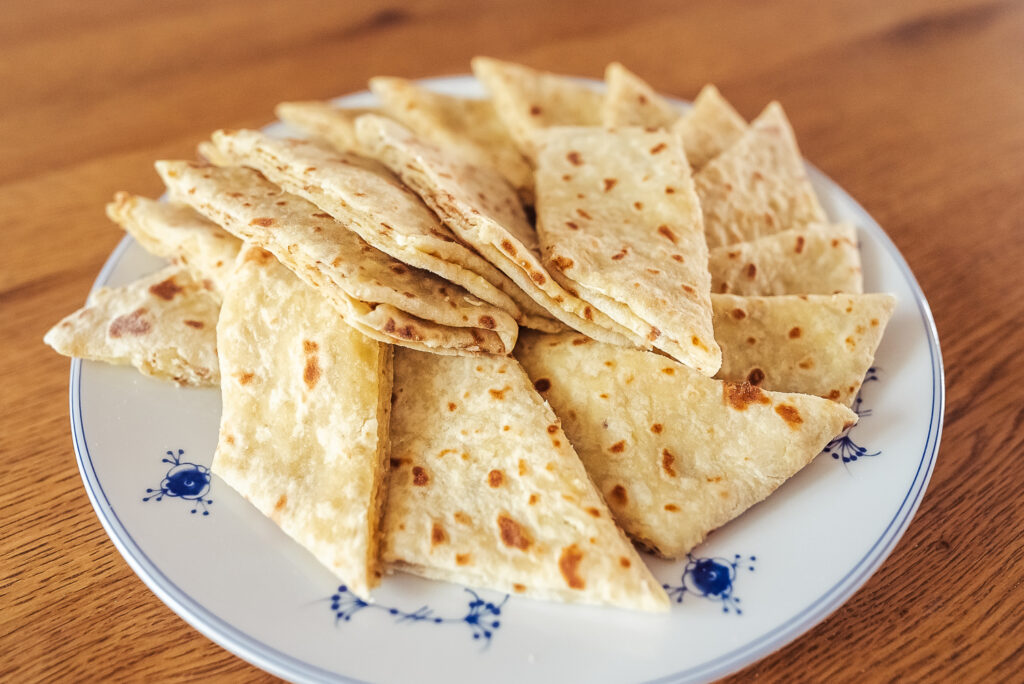
If you’re new to making lefse or need some tips, I’ve also shared a video with tips for making Norwegian potato lefse here:
How to eat lefse
There are many different ways to eat lefse, but my favorite is to fill it with kling, which is a mixture of butter and sugar (and sometimes cream and cinnamon). We usually serve lefse with kling at room temperature, though actually I love to warm it up in the microwave for a few seconds so the butter melts a bit.
Some people also like to eat lefse with Norwegian brown cheese. You can melt the cheese and then spread it across the lefse and roll it up. Or we will fill it with prim, which is like a spreadable brown cheese. You can make your own prim with leftover brown cheese, cream and sugar.
Potato lefse in particular is also often eaten with traditional Norwegian dishes like rakfisk, sylte, and lutefisk. I also like to fill potato lefse with cream cheese and smoked salmon.
To fill the lefse, you can simply cut it into triangles, add the filling, and then roll it up from the tip. Though when filling lefse with kling (butter and sugar) we have a special way of folding the lefse, which I explain in the recipe below.
Lefse, lefsa, or lefser
If you don’t speak Norwegian, you might not know the difference between lefse, lefsa, and lefser. These are all different declinations of the same noun! Ei lefse translates to a lefse, den lefsa translates to the lefse, and lefser is the plural of lefse. So this recipe shows you how to make a lefse, how to fill the lefsa with kling, and at the end you will be able to enjoy all the lefser that you made!
Lefse equipment
You will need some special equipment to make lefser. If you are new to making lefse you might want to buy a lefse starter kit like this one on Amazon, which has everything you’ll need to make Norwegian lefse. If you don’t have a lefse kit, here is what you will need to make lefse:
1. Traditionally we cook lefser on a large steketakke or griddle. I use a 46 cm (18 inch) griddle for my lefser. You can buy a griddle on Amazon here. And of course you can use your griddle to make other things as well, like pancakes and tortillas. But if you don’t have a griddle, you can simply make smaller lefser and cook them in a large dry frying pan instead.
2. You will also need both a regular smooth rolling pin and a corrugated rolling pin. The corrugated rolling pin will help you to roll the lefse quite thin without it breaking or sticking.
3. You will need a long wooden lefse stick to turn the lefse. This isn’t entirely necessary if you’ll be making small lefser on a frying pan, but if you’re making large lefser on a griddle then a lefse stick is essential.
4. You’ll need a pastry cloth to roll out the lefser. In Norway we actually often simply use the back of a cheap vinyl tablecloth to roll out our lefser. You can cut the tablecloth into a circle slightly larger than your griddle or frying pan, so you know about how large to roll out the lefsa.
Lefse tips
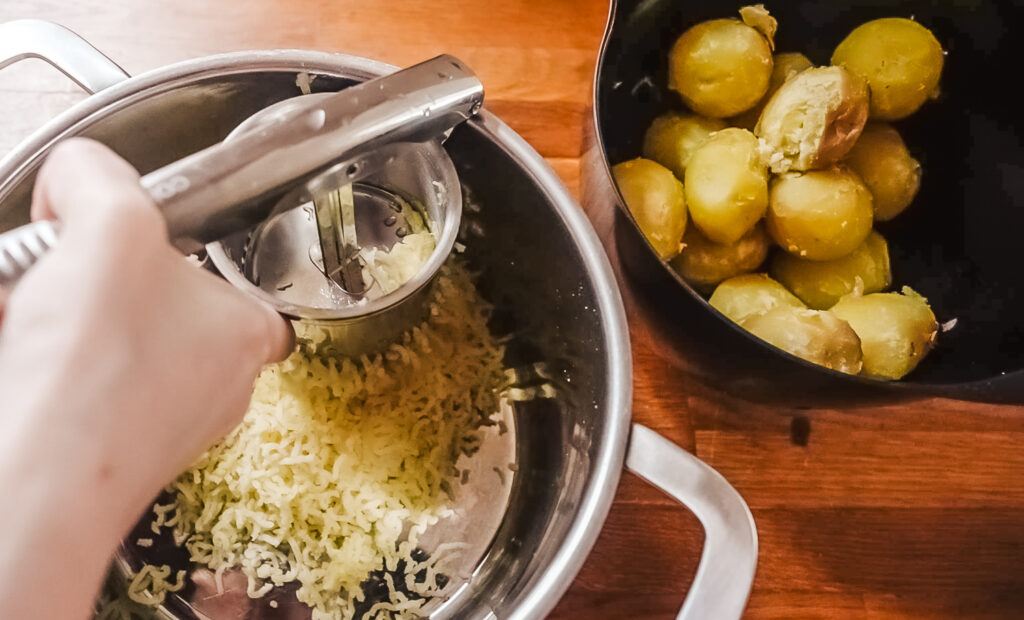
To make the potato lefser I first boil the potatoes with the skins on, and then when they’re still warm I peel them and run them through a potato ricer twice. This ensures that there are absolutely no lumps, and it makes it easier for you to knead the dough later on without overworking it.
After ricing the potatoes, let them cool completely in an uncovered bowl in the fridge so that all the excess moisture evaporates. Some people leave the potatoes in the fridge overnight, however I don’t find that necessary.
Add the flour slowly, as you might not need all of it, depending on how much moisture is in the potatoes. You don’t want to use more flour than necessary, as then the lefsa can become tough.
Knead the lefse dough by hand, not in a machine. You want to knead it until it’s not too sticky to roll out, however you do NOT want to knead it too much. You can check if it’s ready to roll out by rolling the dough into a long sausage and pressing your thumbs into it. If your thumbs come out clean it’s ready, but if they stick to the dough then you should knead it some more and maybe add more flour.
When rolling the dough into individual patties, make sure to take the time to roll them into nice circles. This step is crucial if you want to roll your lefser into nice, round circles. First, I roll the lefse dough into a long sausage and then divide it into about 8 pieces. If you’ll be making smaller lefser, you can divide the dough into smaller sections.
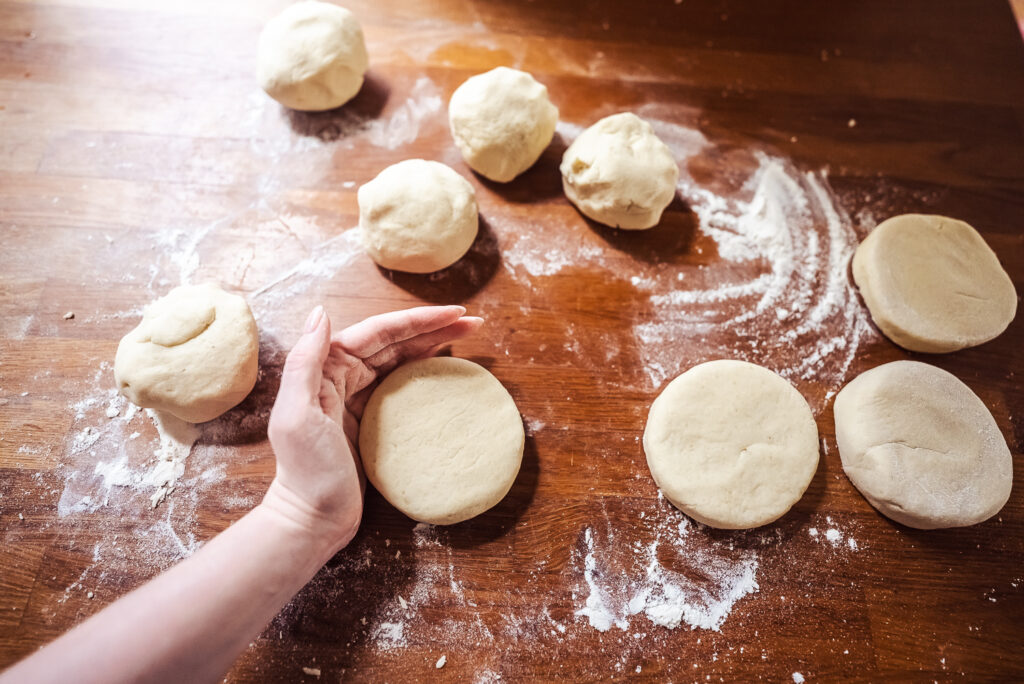
Then roll each section into a nice ball, and flatten the ball with your hand. Use the edges of your hands to cup the dough into a nice circle without any cracks.
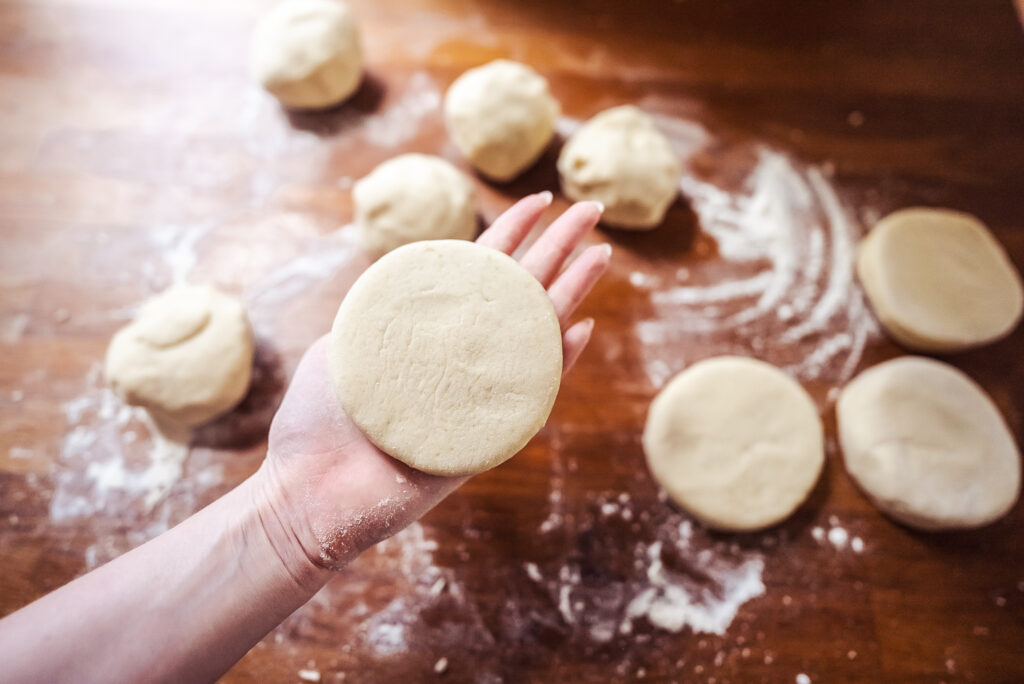
Flour your pastry sheet very well and then begin rolling out each lefse. If the pastry sheet slides around, you can wet the bottom a bit so it sticks to the table.
I like to start with a smooth rolling pin, and then I switch to a corrugated rolling pin to make the lefsa even thinner. I flip the lefsa once before switching to the corrugated rolling pin. Some people like to use a rolling pin cover to prevent sticking, but I don’t find it necessary. Just be sure to use light strokes and concentrate more on the edges than the center.
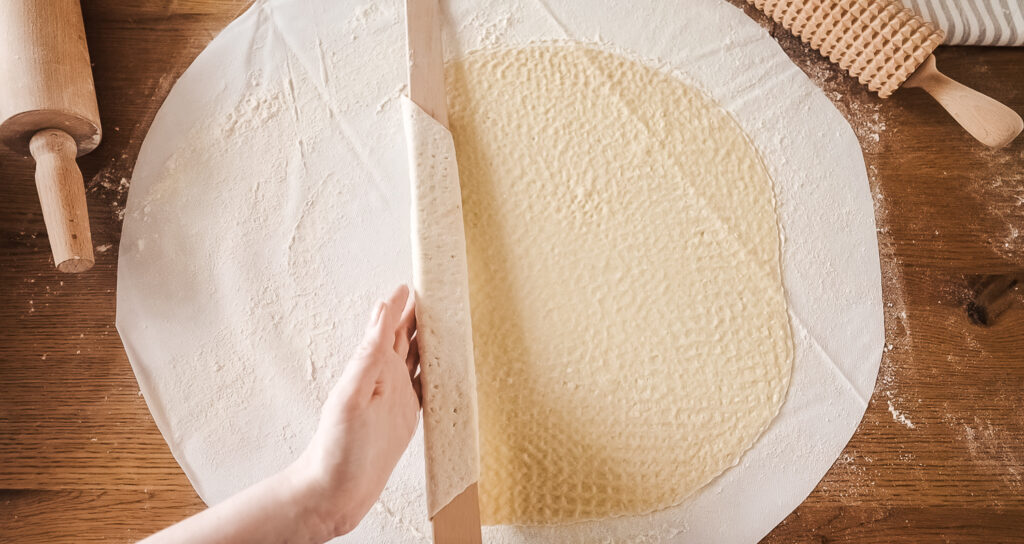
When rolling the lefsa onto your lefse turning stick, be careful not to pull or stretch the lefsa. Gentely turn the stick with your hand.
And the same goes for unrolling the lefsa onto the griddle. Don’t stretch the lefsa across the griddle. Instead gently unroll the lefsa and let it drop onto the griddle (see video below the recipe).
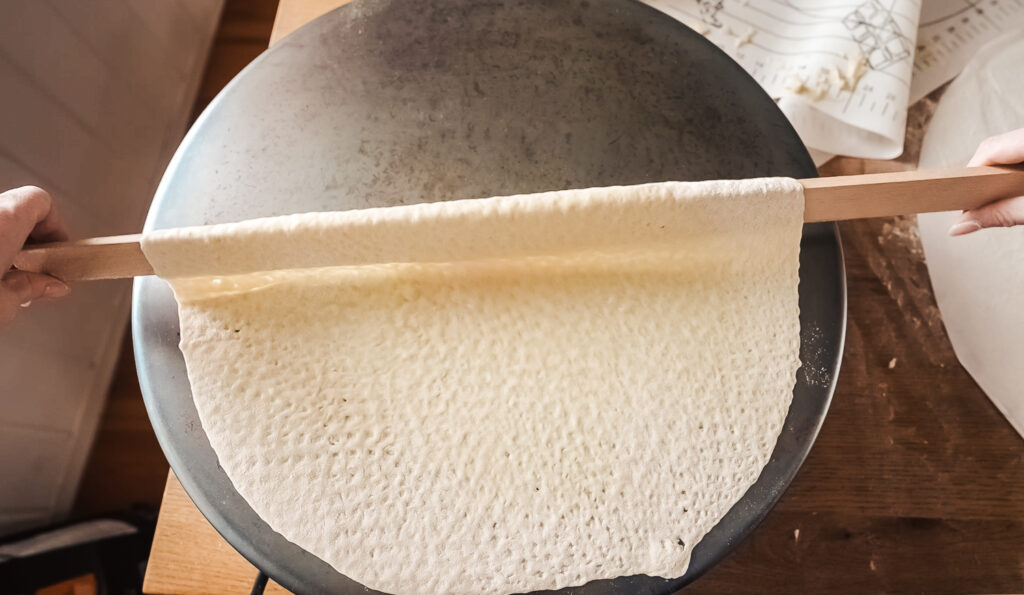
Stack your cooked lefser on top of each other in a dampened sheet or tablecloth. Once they’re cool I fold them and store them in a plastic bag.
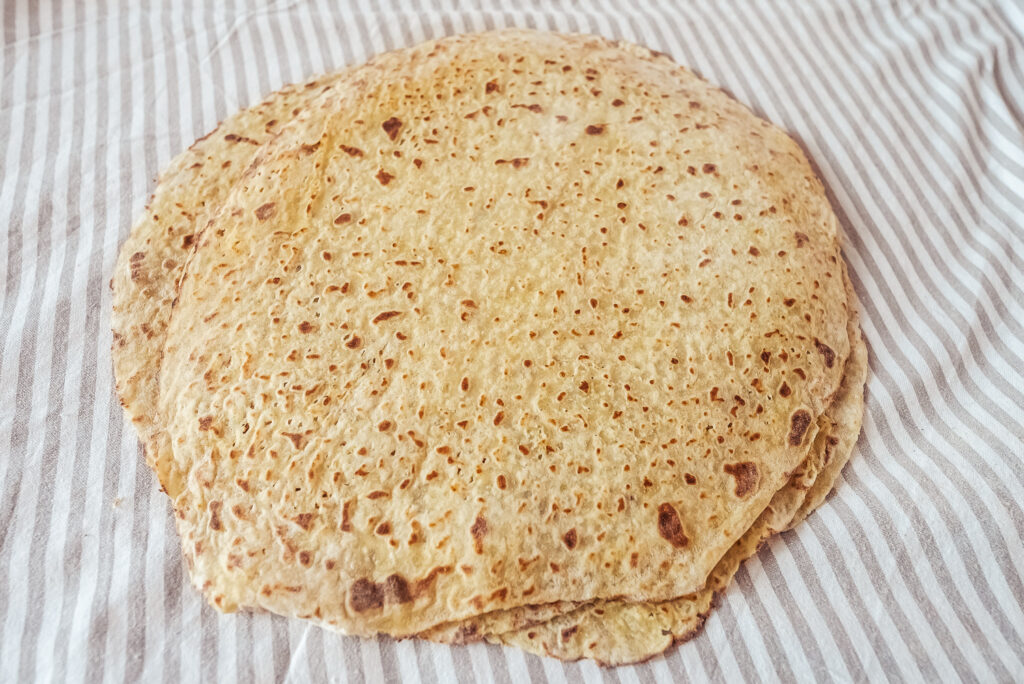
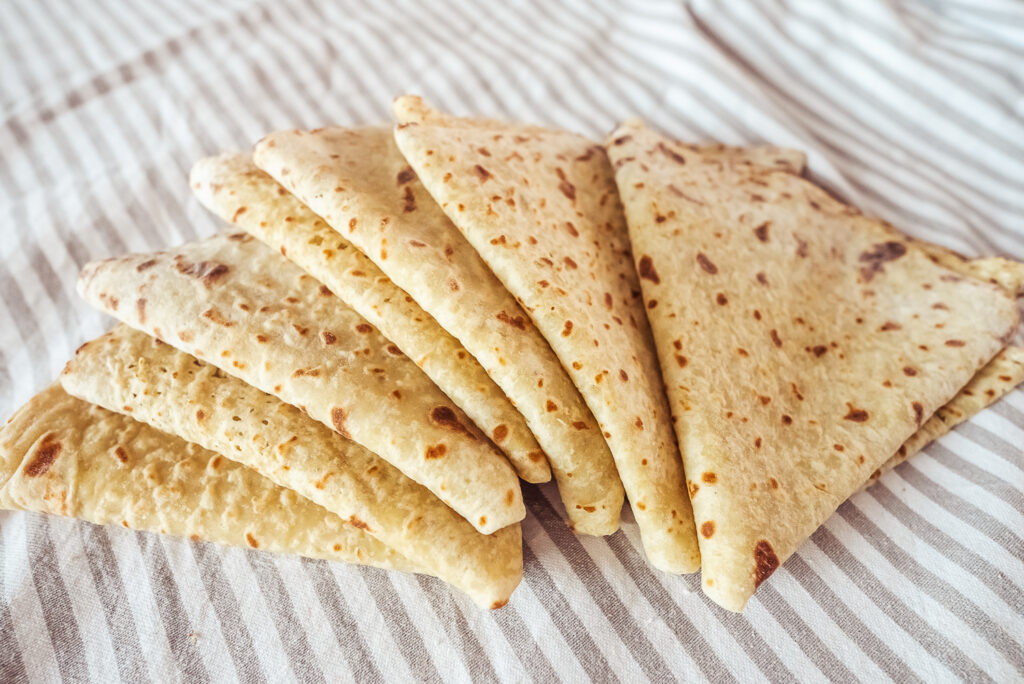
Lefse with kling filling
If making kling with the lefser, mix the softened butter and sugar and cream. You can also add some cinnamon, if you like.
Be sure to spread a very thin layer of the kling across the lefsa – you don’t want it to be too thick.
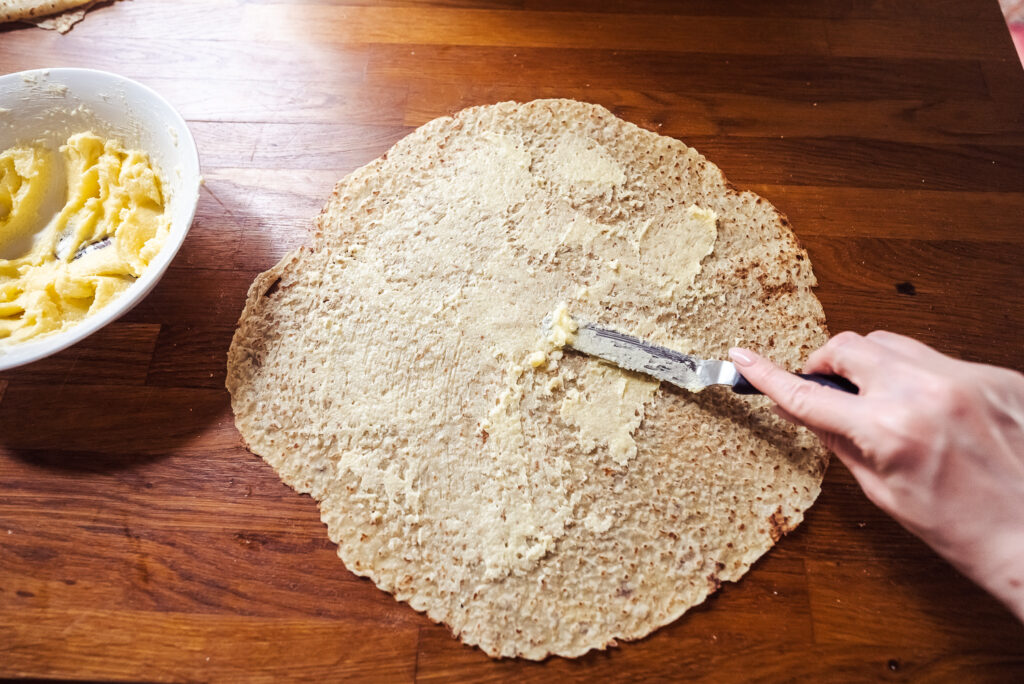
Then fold the edges of the lefsa up into a rectangle, as shown in the video. There’s usually always one lefse that doesn’t turn out that pretty, so I use that one to cut out triangles to fill in the gaps on the folded rectangle. Then I spread another thin layer of kling and fold the lefsa in half. Then cut it into smaller rectangles.
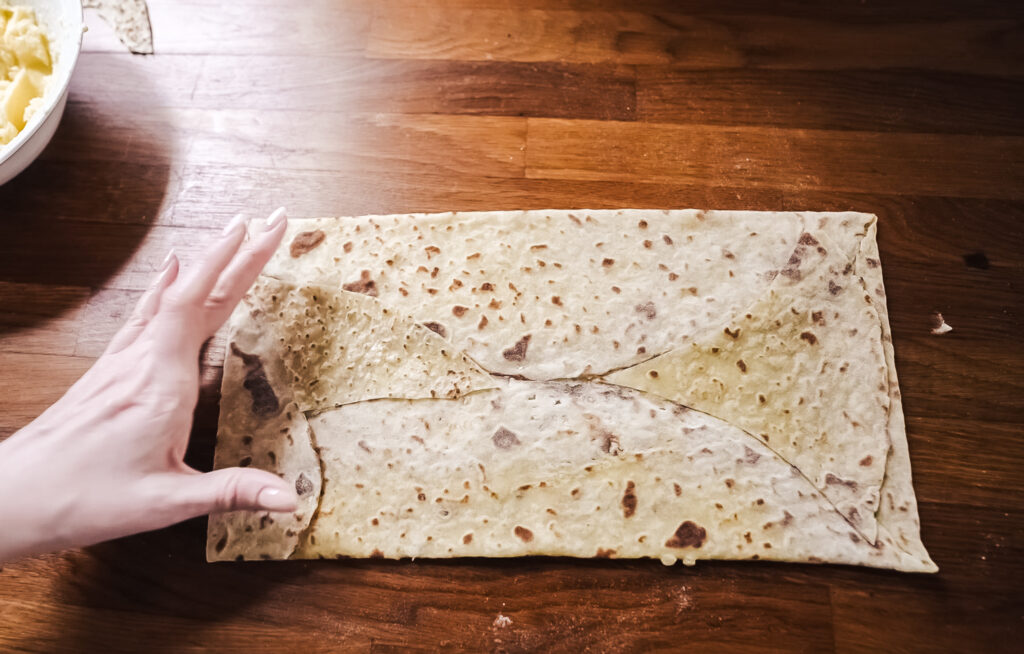
This is the traditional way of folding kling into lefse. However you can also simply spread some butter and sugar across your lefse and roll it up.
You can store your lefser with kling in a plastic bag in the fridge or freezer. It tastes best served at room temperature (actually I like to heat it up a bit – but this is not the traditional way of serving it).
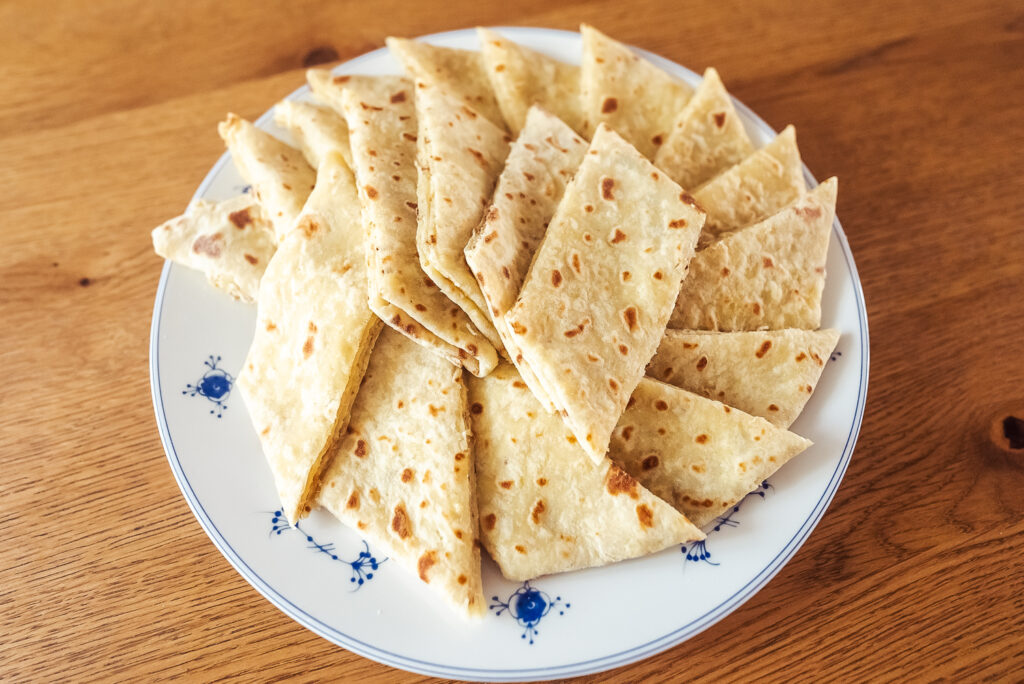
You can switch the recipe from US measurements to metric by clicking from “US Customary” to “Metric” under Ingredients.
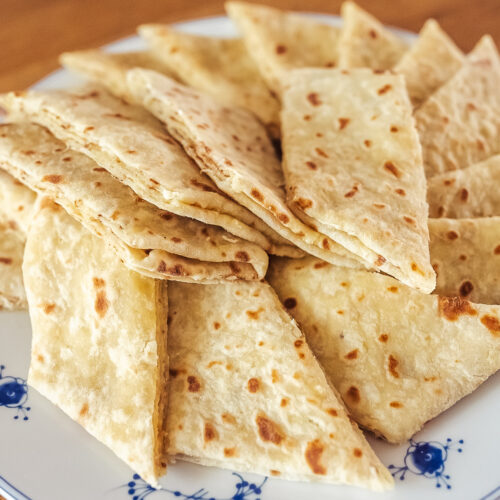
Norwegian Potato Lefse
Equipment
- potato ricer
- Rolling Pin
- corrugated rolling pin
- wax tablecloth or canvas (optional)
- lefse stick
- griddle (or large frying pan)
Ingredients
- 3 lb potatoes
- t tsp salt
- 1 tsp sugar
- 1/4 cup melted butter
- 1/4 cup heavy cream
- 1 and 1/2 cups all purpose flour
- 1/2 cup flour for rolling
(Optional) Kling filling
- 14 tbsp butter (room temperature)
- 3/4 cup granulated sugar
- 1 tbsp heavy cream
Instructions
- Boil the potatoes. Peel the potatoes while still warm and run them through a potato ricer twice.
- Let the potatoes cool in an uncovered bowl in the fridge.
- Stir the salt, sugar, melted butter, and cream into the riced potatoes.
- Slowly add the flour and knead by hand until you get a good consistency. Don't add more flour than necessary! Roll the dough into a long sausage and divide into about 7 or 8 pieces if using an 18 inch griddle. If using a smaller griddle or frying pan, divide the dough into 10 – 12 pieces.
- Roll each piece into a ball and then press into a flat circle, using the edges of your hands to form the dough into a nice circle shape without any cracks. This is important, otherwise you won't get round lefser.
- Heat up your griddle on medium/high heat.
- Flour your rolling surface and roll the lefse dough into a large circle slightly smaller than your griddle or frying pan. Begin rolling with a smooth rolling pin, then switch to a corrugated rolling pin as the lefse gets thinner. Don't use too much flour, as then the edges can become hard.
- Roll the lefse onto your lefse stick and then gently unroll it onto your griddle. After a minute or two check the underside of the lefse for brown spots and then use the lefse stick to flip the lefse and cook on the other side.
- Use the lefse stick to remove the lefse from the griddle and place it in a folded damp sheet or tablecloth.
Kling
- Mix the softened butter, sugar, and cream together until smooth.
- Spread the butter mixture in a very thin layer across the lefse. Fold the edges of the lefse in to make a rectangle (see video). Then cut two triangles from another lefse to cover the empty sections.
- Spread another thin layer of the butter sugar mixture across the rectangle. Fold the rectangle in half and then cut into small rectangles to serve.
- Store the lefse with kling in an plastic bag in the fridge or freezer.
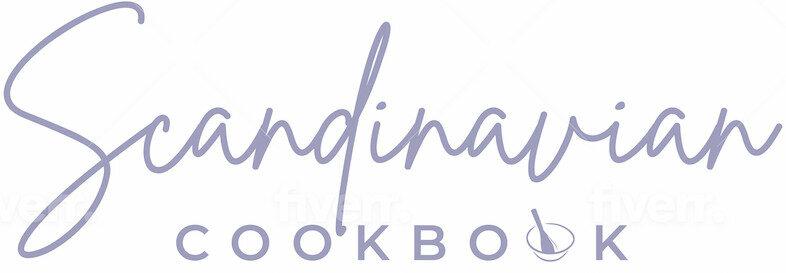
4 Comments
N. Dean Huseby
May 17, 2025 at 12:25 am
I love your videos. I have made lefse for years, but maybe for once, it will actually look a little more professional. Thank you for sharing.
Cate
December 1, 2025 at 10:03 pm
I used all of your tips and practices while trying to recreate my late mother-in-law’s lefse recipe, and your guidance truly meant a lot. The lefse aren’t perfect, but they look and taste wonderful. My only concern is that the dough might have been a little too moist; it wasn’t sticky and it handled without issues, but it grilled a bit softer than hers used to.
Still, my adult son was absolutely thrilled to have lefse again, and that made the whole effort feel really special. Thank you for sharing your methods.
Rochelle
December 21, 2025 at 3:02 am
Quick question, for clarification, when using the back of a cheap vinyl tablecloth, your rolling on the flannel side with flour worked in to prevent it from sticking. Correct?
This is genius. I love the idea of not having to use the canvas on the board for those start out.
Silvia
December 21, 2025 at 11:12 am
Yes, the work flour into the flannel side of the tablecloth. I find it’s the perfect texture 😊